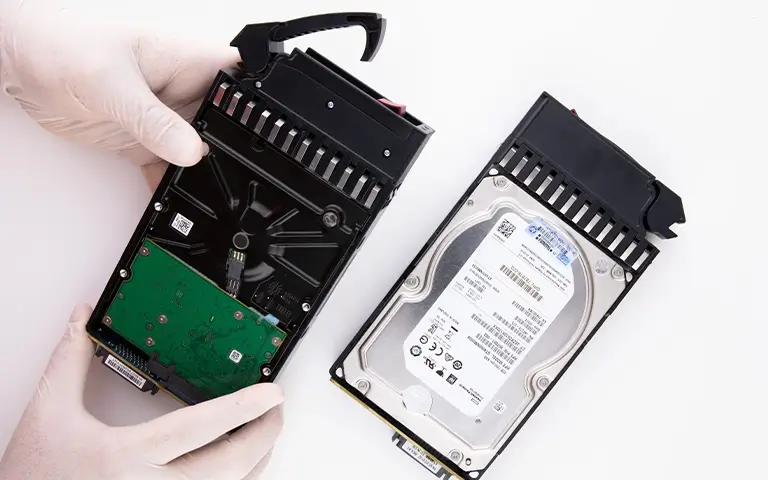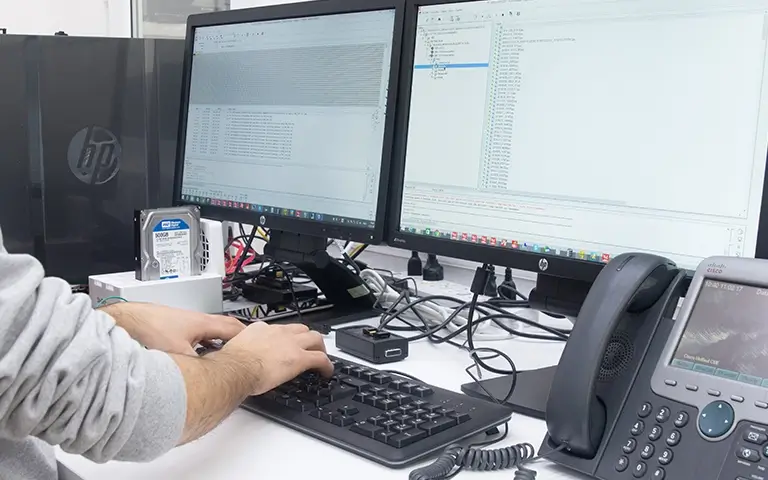A client contacted us after their server stopped recognising both hard drives in a RAID 1 mirror. The system, which held critical business data, showed no accessible volumes at boot, blocking access to essential files.
Following a brief consultation, the customer requested an expedited assessment to limit downtime. The drives, two HPE 3R-A3845-AA 18.2 GB HDDs, were shipped to our lab for urgent diagnostics.
On arrival, engineers at RAID Recovery Services began immediate evaluation to confirm the extent of damage and outline a recovery plan to restore the data as quickly as possible.

Case Overview
The client’s setup used two identical HPE 18.2 GB drives in a RAID 1 array. This level relies on mirroring, with identical data written to both disks to provide redundancy and protect against a single drive failure.
Learn more about how this configuration works in our post on What Is RAID 1.
Over time, one drive began to show performance issues due to sustained workload. The client delayed replacement, assuming the mirror would prevent any data loss.
Both drives had been purchased together and operated under the same conditions, so their life cycles were almost identical.
When the second drive failed soon after, the server lost access to the mirrored volume. The system became inoperable and the stored files were unavailable. This near simultaneous failure created a complex RAID 1 data recovery scenario requiring physical repair and advanced reconstruction.
Initial Evaluation Process
Our team applied a structured approach during the expedited assessment to identify the fault quickly and safely:
Drive inspection: The HPE disks were visually checked for physical damage or contamination before diagnostics.
Software diagnostics: Each drive was tested with diagnostic tools, but neither was detected in the BIOS, indicating a serious hardware failure.
Cleanroom transfer: The drives were moved to our ISO certified cleanroom to ensure a dust free, controlled environment.
Component evaluation: Inside the cleanroom, an engineer examined internal components including heads, platters and the spindle motor to pinpoint the failure.
This systematic evaluation confirmed that mechanical repairs were required before any data extraction could begin.

Problem Diagnosis
During cleanroom inspection, the engineer confirmed spindle motor damage on both hard drives, specifically within the hydraulic bearings. This type of failure is common when disks are continuously overloaded or run for long periods without maintenance.
Because the spindles could not achieve stable rotation, the platters failed to spin correctly and the heads were unable to read data. This also explains why the drives were not recognised by the BIOS during initial tests.
Mechanical issues of this kind are typical in heavily used or ageing drives and are often preceded by unusual noises before complete failure. For more context on how these symptoms develop, see our article on Hard Drive Clicking Sound.
Early identification of the defective components enabled us to plan a precise RAID 1 data recovery strategy using matched donor parts.

Data Recovery Process
After confirming spindle motor failure, our engineers executed a staged procedure to restore the mirrored RAID 1 data:
The failed drives were opened in the cleanroom to maintain a strictly controlled environment throughout the work.
Magnetic platters were carefully removed and installed into donor drives with identical specifications to achieve stable rotation and readable alignment.
With stability achieved, each donor assembly was imaged sector by sector to preserve all data from both mirrored disks.
Using diagnostic software, we rebuilt the RAID 1 virtually and aligned data from both images for consistency. Accurate configuration was essential, as outlined in RAID Controller Failure Recovery.
Files were extracted, checked for integrity and validated against the client’s requirements.
This careful, step by step workflow enabled a complete RAID 1 data recovery without risking further data loss.

Results and Outcome
After the procedures, we issued a full evaluation outlining estimated recovery percentage and turnaround. The client approved immediately, and extraction began.
Both disks were successfully imaged, and the RAID 1 was reconstructed with no data loss. All files were restored, integrity checked and delivered within the agreed window.
This case shows that mirrored arrays can still fail when ageing drives are not replaced promptly. With a structured RAID 1 data recovery process, the client regained full access and restored server functionality in under 24 hours.
Fast turnaround times for business-critical data
Lessons Learned and Prevention Tips
This case underscores the need for timely maintenance and active monitoring in mirrored arrays. RAID 1 offers redundancy, but it cannot protect against near-simultaneous drive failure. To avoid similar incidents, our engineers recommend:
Replace drives promptly: If one drive in a RAID 1 set fails, replace it immediately to restore full redundancy.
Avoid overloading servers: Continuous strain shortens the lifespan of disks and other components.
Monitor drive health: Use system tools to track temperatures, SMART attributes and performance to spot early warning signs.
Schedule regular maintenance: Review logs, update firmware and run periodic drive tests.
Implement data safety practices: Follow proven measures from our Data Loss Prevention guidance to mitigate hardware and human related risks.
These actions materially extend RAID reliability and help prevent costly downtime.

Conclusion
This successful RAID 1 data recovery demonstrates how professional expertise and controlled handling can restore severely damaged drives.
Despite both disks failing, our engineers reconstructed the mirror and recovered every critical file safely.
At RAID Recovery Services, we specialise in complex RAID incidents involving physical and logical faults. With precise diagnostics, cleanroom procedures and secure recovery techniques, we help organisations regain access to vital data with minimal downtime.
If your RAID 1 array or server has stopped responding, contact our team for a professional evaluation and rapid, reliable recovery.
Trust the experts with proven results
Frequently Asked Questions
What caused the RAID 1 system to fail in this case?
Both disks failed due to sustained workload and ageing components. Installed together, their lifespans ended almost simultaneously, resulting in a complete RAID 1 failure.
Can data be recovered if both drives in a RAID 1 array fail?
Yes. Specialists can transfer platters to matched donor drives, image the media and reconstruct the RAID 1 virtually to recover files, as in this case.
How long does a RAID 1 recovery usually take?
Timelines depend on damage and capacity. Expedited assessments can finish in hours, while full recovery for severe failures may take one to two days.
What are common warning signs of a RAID 1 drive failure?
Slow performance, unusual noises and read or write errors often signal a failing mirror disk. Acting early can prevent full system outage.
How can I prevent RAID 1 data loss in the future?
Replace failed drives immediately, monitor SMART and temperatures, schedule preventative maintenance and keep verified backups. See our Data Loss Prevention guidance for ongoing protection.